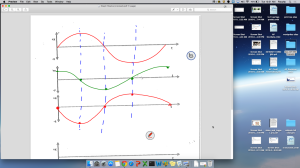AP Physics 1
This year in AP Physics 1, I began the year with kinematics in 1D. I moved on to a brief coverage of vectors and relative motion before discussing projectiles. I gave a pretty short time to projectiles because these students have had physics before, even if it was three years ago, and I believe the conceptual foundation is still there. The algebra skills are there, certainly. I made sure we did some graph stacks, and that was about it conceptually.
We had a test on kinematics in 1D and 2D, and have since moved on to the kinematics of Simple Harmonic Motion. This is an unorthodox second unit, but last year’s AP1 class experience caused me to think that this would be a very helpful topic to have at the very beginning of the year. Last week I had students do a prelab to graph the force-displacement graph for each of a pair of stretchy springs – Hooke’s Law. I just wanted them to find the “k” value of the springs and to think of that value as nothing more than the slope of the F-vs-delta-x graph. We barely had to talk about what a force is, in order to accomplish this prelab. It went well, and the following day the lab groups used their spring pairs to set up horizontal oscillators on a Pasco track. The springs went on the ends of a Pasco track and were stretched out and hooked onto the track stops. A few quick video captures and position tracking showed the following:
- Hey, it’s a sine wave. Or a cosine. Or a negative cosine I guess. (Okay they’re all sinusoids! That’s a vocab word).
- Hey, changing the amplitude doesn’t cause the period to change. (That’s a vocab word)
- Hey, putting masses in the cart makes the period increase but it’s not a linear relationship. Weird.
That’s all I wanted, so I was very happy with the results. I showed the students the Ts formula on the formula sheet and we did some algebraic acrobatics to verify that we could calculate things from the lab or from test-like questions.
But for me, the real payoff came this week, when I put a SHM position-time graph on the board and I asked the students to walk me through a graph stack to make velocity-time and acceleration-time graphs. I cannot emphasize how wonderful it is to do this with students who are in precalculus or maybe AP Calc AB. They do not yet know the derivative of the sine function, so we actually had to talk it out. Show me all the points where the slope is zero. Now show me where it is the most positive. And what does it do in between the zero and the most positive? They walked me through it and they told me it was easy. That’s the best kind of teaching.

Recent Comments